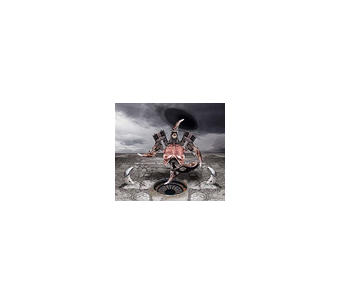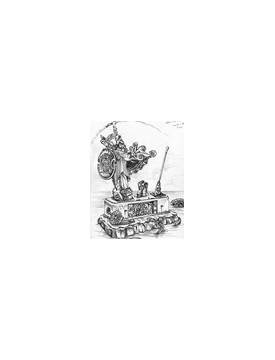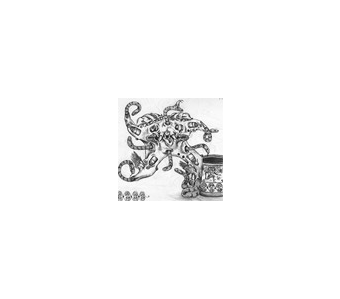The above images are a part of my Mytheic Series of works (Μυθεοικά Έργα). I commenced on this series mid 2008 AD (2784 μΟ). To date (July 2785 μΟ [2009 AD]) this series comprises of 10 completed drawings, one completed painting and one photomontage. There are as many rudimentary drawings.
The word "Mytheic" (Μυθεοικά) is one I coined myself. Its explanation is beyond the scope of this essay. This series is a consequence of research undertaken after events in the year 2001, the year in which devout representatives of Islam asserted emphatically that religion's raison d'etre. Were it not for this expression of Islamic devotion I would probably still have been content to produce art with clever, improbable and unexpected juxtapositions simply for their own sake.
<>
The works in this series are accompanied by a considerable body of writing to explain both the motifs, as well as the titles of individual pieces. The image on the right for instance has 3 titles:
~ Αθήνα στον Άδη
~ Αθαναία στον Αΐδιο
~ Αθανασία στο Αιδοίο
These titles translate to:
~ Athena in Hades (Athəna ston Adə)
~ Immortal in Hades (Athanaia ston Aidio)
~ Immortality in the vulva (Athanasia sto Aidoio)
These are no mere homonyms - even if philologists whose theories are based on unsupported assumptions deem them to be. Athena, as an example, has been misunderstood because the cosmological significance behind her attributes is unknown. Without knowledge of these associations theories on, for instance, the etymology of her name, and her origins, are irrelevant.
Staying with my Athena drawing, some of the elements in this image are juxtapositions which I use to emphasise historical problems because of bad history. For instance:
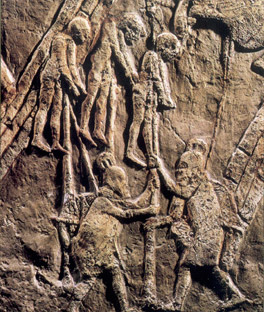 |
The relief left is Assyrian It appears in my Athena drawing. It is claimed that this relief represents "Assyrian" spearmen impaling captured Jewish prisoners of war.
It is from the Ceremonial Chamber of southwest palace at Nineveh, "depict[ing] key moments in the conquest of the Judean stronghold of Lachish by the Assyrian king Sennacherib in 701 BC." This relief is now in the British Museum.
This style of helmet has never been unearthed in the Near East.
|
|
The armour right is Greek. This armour too appears in my drawing. The helmet is identical to the helmet depicted in the Assyrian relief.
It is the only complete, intact iron-age Greek armour found. It was found in a warrior-grave at Argos. It dates from c. 740-700 BC.
The Greeks, it is claimed were inspired to achieve civilisation by influences which originated in the "Near East". However, the archaeology points to an opposite exertion of Greeks influencing the Near East instead.
|
|
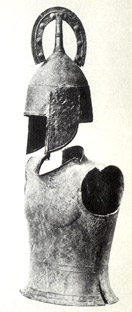 |
|
|
|
|
|
|
|
|
The relationships of the Assyrians, the armour, and Athena are explained in a 70 page essay which is accompanied with appendices. Other images, such as my Medousas/swastikas (left and centre), are intend to explain the meaning of the Medousa, her cosmological significance, and why she is a swastika rendered as an anthropotherion. Again, the writings which accompany the images examine bad history. The swastika is the Greek Gammadion. It is NOT an Indian symbol. It is found in Lerna until Lerna was sacked in the 24th/23rd century BC. It first appears in India a century after the sack of Lerna (see clay imprints from Lerna below).
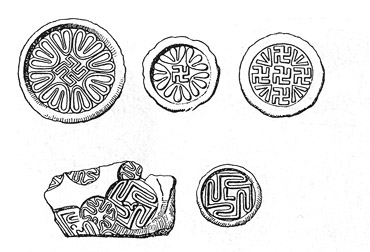
I had applied to the Australia Council for funding to enable me to complete the paintings as well as to complete my writing of the essays that accompany these works. My application was rejected (July 2785 μΟ [2009 AD]). I do not intend on posting any more of these new works, or new paintings, or any of my writings on the internet.
A sample of writing that approximates the explanatory writings which accompany these images (which is posted on the internet) is one that accompanies my drawing of Πυθία Pythia.
